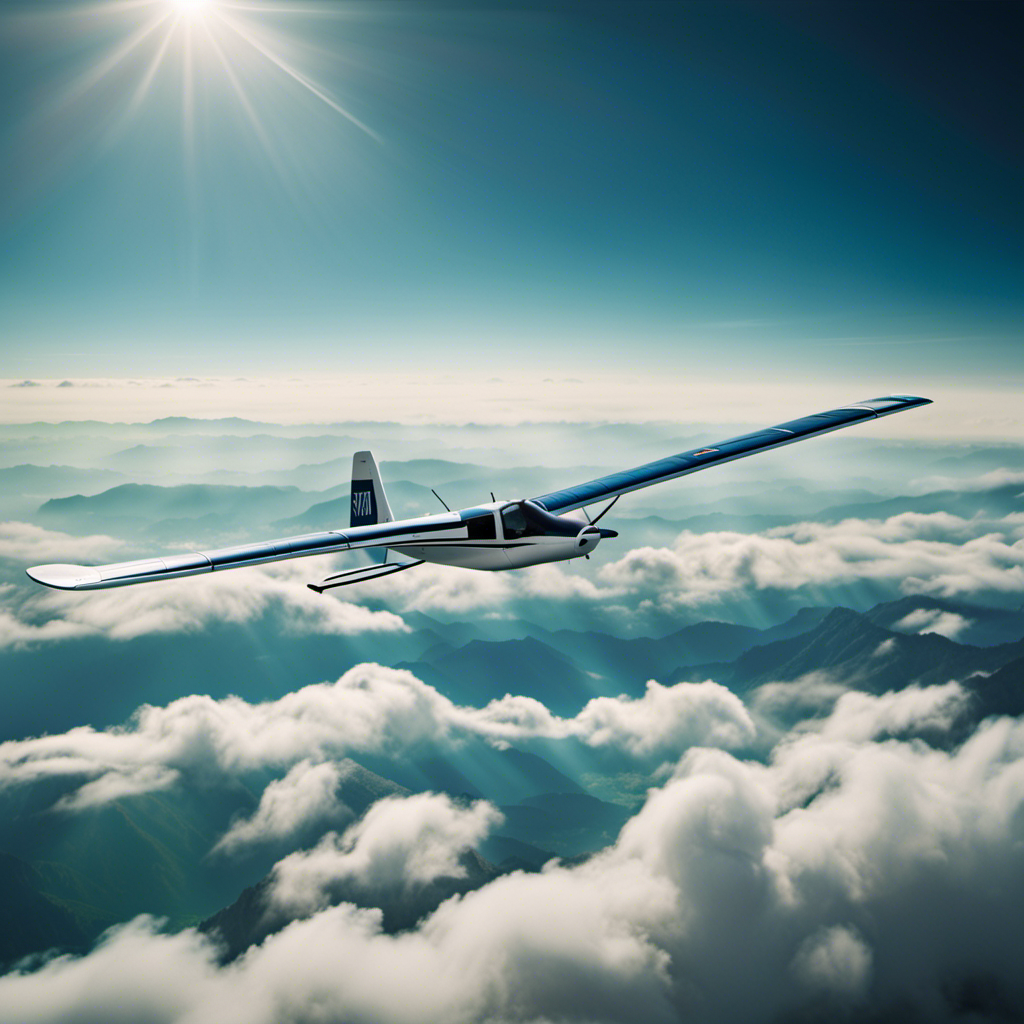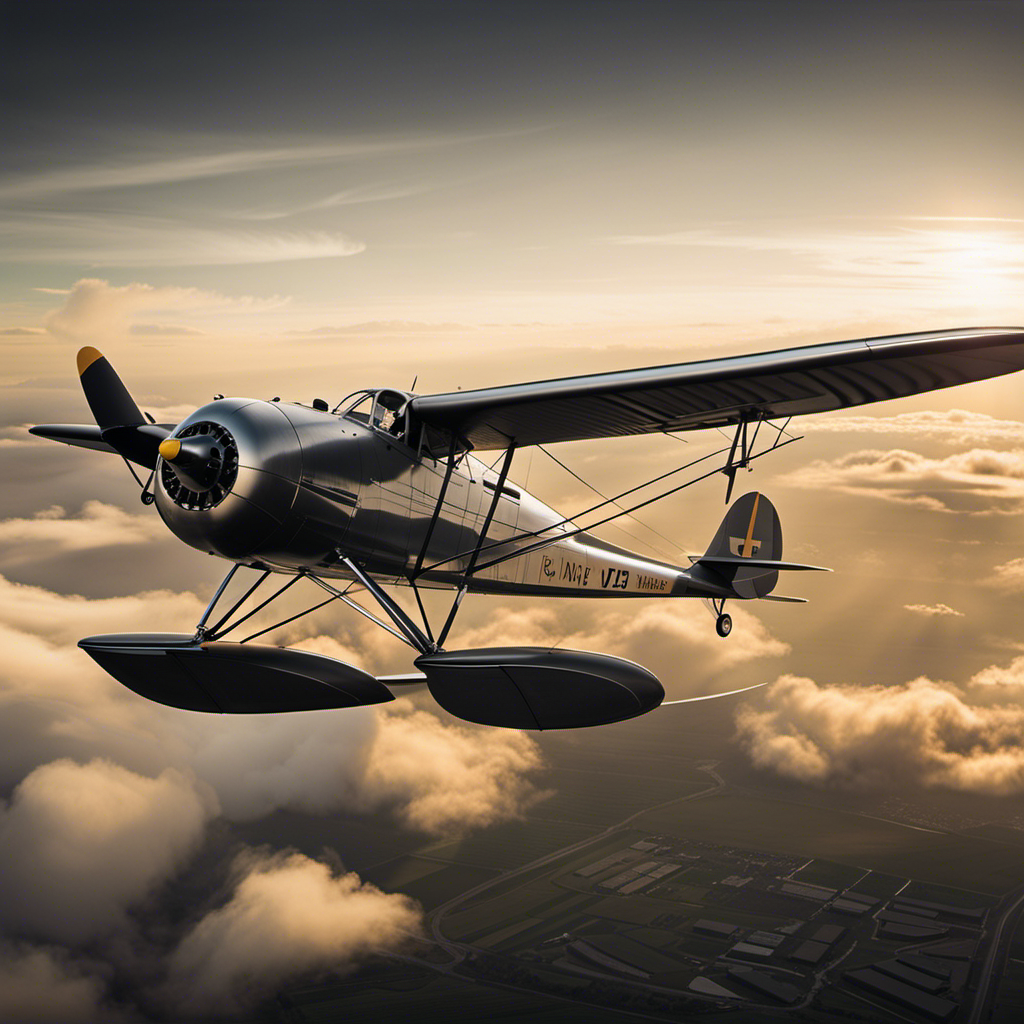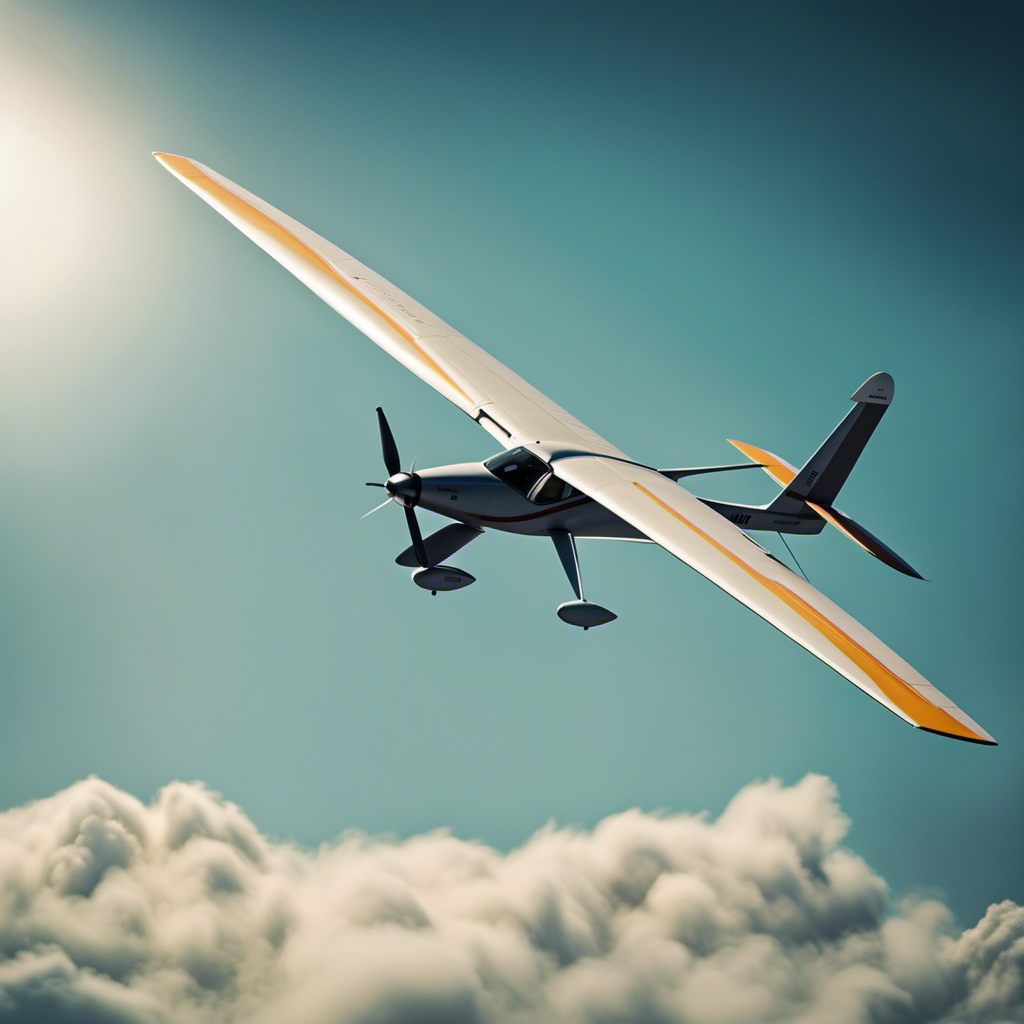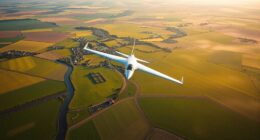You might be wondering, how do airplanes defy gravity and stay in the air? Let me explain this to you thoroughly and with technical precision.
In this article, I will explain the basic principles of flight, the role of wings and airfoils, the power of engines, and the importance of control surfaces and stability.
We will also explore the influence of weight and balance, the role of avionics and navigation, and the impact of weather on flight.
And of course, we can’t forget about maintenance and safety, as well as future innovations in aviation.
So, buckle up and get ready to soar through the fascinating world of flight!
Key Takeaways
- Lift is generated by wings and influenced by shape, size, and angle of attack.
- Thrust propels the aircraft forward, overcoming drag.
- Control surfaces like ailerons, elevator, and rudder maintain stability.
- Avionics and navigation systems are crucial for successful flight.
The Basic Principles of Flight
The basic principles of flight can be understood through a combination of lift, thrust, drag, and weight. When it comes to aircraft design, lift generation is crucial.
Lift is the force that allows an aircraft to stay airborne. It is generated by the wings and is influenced by factors such as the shape, size, and angle of attack of the wings. As air flows over the wings, it creates a pressure difference, with the air moving faster over the curved upper surface than the flat lower surface. This pressure difference generates lift, counteracting the force of gravity.
Thrust, on the other hand, is the force that propels the aircraft forward, overcoming drag. Understanding these fundamental principles is essential for comprehending the role of wings and airfoils in flight.
The Role of Wings and Airfoils
As you explore the role of wings and airfoils, you’ll discover how they help you stay airborne. Wing design and lift are crucial factors in achieving flight.
The shape and size of the wing, along with its angle of attack, determine how much lift it generates. The curved shape of the wing, known as the airfoil, plays a significant role in aerodynamic efficiency. Different airfoil shapes have varying lift and drag characteristics, allowing for optimized performance in different flight conditions.
The Power of Engines
When it comes to the power of engines, there are three key points to consider.
Firstly, jet engines and propulsion. Jet engines work by intaking air, compressing it, and then igniting it with fuel to create a high-pressure, high-velocity exhaust that propels the aircraft forward.
Secondly, propellers and rotary engines. These types of engines use rotating blades or cylinders to generate thrust.
Lastly, the thrust-to-weight ratio. This is a crucial factor in determining an aircraft’s performance. It measures the amount of thrust the engine produces compared to the weight of the aircraft.
Jet engines and propulsion
To understand how they stay in the air, you gotta know how jet engines and propulsion work. Jet engines, like the ones used in commercial aircraft, are designed to generate thrust by expelling high-speed exhaust gases. This propulsion method relies on the principle of Newton’s third law of motion, which states that for every action, there is an equal and opposite reaction.
Here’s a deeper look at the key elements of jet engine design and alternative propulsion methods:
-
Jet engine design:
-
Intake: Air is sucked into the engine through the intake, compressed, and mixed with fuel.
-
Combustion: The compressed air-fuel mixture is ignited, creating a controlled explosion.
-
Exhaust: The hot, high-speed gases produced by combustion are expelled through the exhaust nozzle, generating thrust.
-
Alternative propulsion methods:
-
Electric propulsion: Electric motors powered by batteries or fuel cells can provide propulsion for smaller aircraft.
-
Hybrid propulsion: Combining traditional jet engines with electric motors can increase efficiency and reduce emissions.
-
Nuclear propulsion: Experimental designs explore the use of nuclear power to drive aircraft propulsion.
Understanding the principles behind jet engines and exploring alternative propulsion methods can help us grasp the intricacies of how aircraft stay in the air. Now, let’s delve into the world of propellers and rotary engines.
Propellers and rotary engines
You can gain a deeper understanding of aircraft propulsion by exploring the mechanics of propellers and rotary engines.
Propellers are one of the oldest and simplest forms of aircraft propulsion. They work by creating thrust through the rotation of angled blades. As the propeller spins, it pushes air backwards, generating forward momentum. The efficiency of a propeller depends on its design, size, and the speed at which it rotates.
On the other hand, rotary engines, also known as Wankel engines, are a type of internal combustion engine that use a triangular rotor instead of pistons. The rotary motion of the rotor produces the power needed for propulsion.
Understanding the intricacies of propellers and rotary engines allows us to appreciate the diversity of propulsion systems in aviation.
Now, let’s delve into the concept of thrust-to-weight ratio.
Thrust-to-weight ratio
The thrust-to-weight ratio is a crucial factor in determining an aircraft’s performance capabilities. It measures the amount of thrust an aircraft engine produces compared to its weight. A high thrust-to-weight ratio allows the aircraft to accelerate quickly and climb steeply, while a low ratio results in slower acceleration and reduced climbing ability.
Managing thrust is essential in controlling the aircraft’s flight dynamics. Here are some key points about thrust management and its impact on flight:
- Thrust-to-weight ratio directly affects an aircraft’s takeoff performance and climb rate.
- The ratio is influenced by factors such as engine power, aircraft weight, and aerodynamic efficiency.
- Pilots must carefully manage thrust during different stages of flight, such as takeoff, climb, cruise, and descent.
- Achieving optimal thrust management enhances fuel efficiency and overall aircraft performance.
Understanding the role of thrust-to-weight ratio in flight dynamics lays the foundation for comprehending control surfaces and stability, which will be discussed in the next section.
Control Surfaces and Stability
Try adjusting the control surfaces to maintain stability while you’re in the air. Stability control is crucial in ensuring a smooth and controlled flight. These control surfaces, such as the ailerons, elevator, and rudder, work together to counteract the aerodynamic forces acting on the aircraft.
The ailerons, located on the wings, control the roll of the aircraft. By raising one aileron and lowering the other, the pilot can induce a roll motion.
The elevator, located on the tail, controls the pitch of the aircraft. By moving the elevator up or down, the pilot can control the nose-up or nose-down attitude of the aircraft.
Lastly, the rudder, also located on the tail, controls the yaw of the aircraft. By moving the rudder left or right, the pilot can control the side-to-side movement of the aircraft.
These control surfaces, when adjusted correctly, help maintain stability and control during flight.
Now, let’s move on to discuss the influence of weight and balance on aircraft flight.
The Influence of Weight and Balance
To maintain stability during flight, it’s important to consider the influence of weight and balance on the aircraft.
Weight distribution plays a crucial role in determining the center of gravity, which is the point where the aircraft is balanced. The center of gravity affects the stability, control, and maneuverability of the aircraft.
Proper weight distribution ensures that the aircraft remains balanced and does not tip or become unstable during flight. It is essential to calculate and monitor the weight and balance of the aircraft, taking into account factors such as fuel, passengers, cargo, and equipment.
Understanding Aerodynamics
Now that we understand the importance of weight and balance in aircraft, let’s delve into the fascinating world of aerodynamics.
Aerodynamics is the branch of physics that deals with the motion of air and the forces acting on objects in it. When it comes to flying, three key concepts come into play: lift, drag, and stall.
-
Lift: It’s the force that allows an aircraft to overcome gravity and stay in the air. It’s generated by the shape of the wings and the speed at which the air flows over them.
-
Drag: This is the resistance that opposes the aircraft’s forward motion. It’s caused by the friction between the aircraft and the air, as well as the shape of the aircraft and any protruding objects.
-
Stall: A stall occurs when the angle of attack of the wings exceeds a certain limit, causing a loss of lift. This can happen at any altitude and can be dangerous if not properly managed.
-
Effect of altitude on aerodynamics: As altitude increases, the air density decreases, which affects the performance of an aircraft. Reduced air density leads to reduced lift and increased stall speed, requiring pilots to adjust their approach and landing techniques.
Understanding the principles of aerodynamics is crucial, especially when it comes to the role of avionics and navigation in ensuring a safe and efficient flight.
The Role of Avionics and Navigation
When it comes to understanding the role of avionics and navigation in flying, you’ll find that they play a crucial part in ensuring a safe and efficient flight.
Avionics systems encompass a wide range of electronic devices and systems that are installed in an aircraft to assist in various functions, such as communication, navigation, and monitoring of critical aircraft systems.
Navigation technology, on the other hand, refers to the tools and techniques used to determine the aircraft’s position and guide it along a desired route. This includes instruments like GPS, gyroscopes, and inertial navigation systems.
By integrating avionics systems with advanced navigation technology, pilots are able to accurately navigate through airspace, avoid obstacles, and maintain situational awareness. This seamless integration is essential for the overall safety and efficiency of the flight.
Speaking of safety, weather conditions can greatly impact flight operations.
Weather and its Impact on Flight
You’ll notice that weather conditions can have a significant impact on your flight. Weather impact is a crucial factor when it comes to flight safety. As a pilot, I must always consider the weather conditions before taking off.
Strong winds, heavy rain, or low visibility can make flying challenging and potentially dangerous. Adverse weather conditions can affect the aircraft’s performance, navigation systems, and even communication with air traffic control. It is essential to closely monitor weather forecasts and updates to make informed decisions about flight routes and altitudes.
By understanding the potential impact of weather on flight, I can prioritize safety and ensure a smooth and secure journey for myself and the passengers.
Now let’s discuss the importance of maintenance and safety in aviation.
The Importance of Maintenance and Safety
After understanding the impact of weather on flight operations, it is crucial to delve into another critical aspect of aviation: maintenance and safety.
As an aircraft pilot, I’m well aware of the importance of following strict maintenance protocols and safety guidelines to ensure the continued airworthiness of the aircraft.
Maintenance protocols involve regular inspections, servicing, and repairs to keep the aircraft in optimal condition.
Safety guidelines encompass various procedures and regulations that prioritize the well-being of everyone involved in aviation, from passengers to crew members. These protocols and guidelines are meticulously designed to mitigate risks and prevent accidents.
Adhering to them not only guarantees the safety of all individuals but also maintains the efficiency and reliability of the aircraft.
Looking ahead, let’s explore the future innovations in aviation that will further enhance the safety and performance of aircraft.
Future Innovations in Aviation
As an aviation enthusiast, I am excited to delve into the future innovations in the industry.
Three key areas that have been gaining significant attention are electric and hybrid aircraft, supersonic and hypersonic flight, and autonomous and drone technology.
Electric and hybrid aircraft are revolutionizing the way we think about aviation by reducing emissions and noise pollution.
Supersonic and hypersonic flight, on the other hand, promise to dramatically decrease travel times and open up new possibilities for global connectivity.
Lastly, the advancements in autonomous and drone technology are reshaping industries such as delivery, surveillance, and even passenger transportation.
Electric and hybrid aircraft
Electric and hybrid aircraft are becoming increasingly popular due to their lower emissions and improved fuel efficiency. These innovative aircraft utilize electric propulsion systems, which rely on electric motors powered by batteries or hybrid systems that combine electric motors with traditional fuel-powered engines.
Here are some key aspects of electric and hybrid aircraft:
- Electric propulsion: These aircraft use electric motors to generate thrust, eliminating the need for conventional jet engines.
- Sustainable aviation: With lower emissions and reduced reliance on fossil fuels, electric and hybrid aircraft contribute to sustainable aviation practices.
- Improved fuel efficiency: Electric and hybrid aircraft consume less fuel compared to traditional aircraft, resulting in cost savings and reduced environmental impact.
- Noise reduction: Electric motors produce less noise than conventional engines, making electric and hybrid aircraft quieter during flight.
- Battery technology: Advances in battery technology are crucial for the development of electric and hybrid aircraft, enabling longer flight durations and increased power capacity.
As we explore the future of aviation, the next section will delve into the exciting realm of supersonic and hypersonic flight.
Supersonic and hypersonic flight
Supersonic and hypersonic flight is pushing the boundaries of speed and revolutionizing the future of air travel. At supersonic speeds, an aircraft is traveling faster than the speed of sound, while hypersonic flight exceeds five times the speed of sound. Achieving these incredible velocities requires meticulous engineering and a deep understanding of aerodynamics.
As an aircraft reaches supersonic speeds, it encounters a phenomenon known as aerodynamic heating. The air molecules surrounding the aircraft compress and generate intense heat, which poses significant challenges to the structural integrity of the vehicle. Engineers employ advanced materials and innovative cooling systems to mitigate this issue.
By overcoming these obstacles, supersonic and hypersonic flight promise to reshape the world of aviation, enabling faster and more efficient travel.
Looking ahead, let’s explore the exciting developments in autonomous and drone technology.
Autonomous and drone technology
The advancements in autonomous and drone technology are revolutionizing various industries and opening up new possibilities for efficiency and innovation.
One of the most significant areas of development is in drone applications for autonomous delivery. With the ability to navigate and transport goods without human intervention, autonomous delivery drones have the potential to transform the logistics industry.
These drones can efficiently and accurately deliver packages to remote or hard-to-reach locations, reducing delivery times and costs. They are equipped with advanced sensors, GPS technology, and obstacle avoidance systems to ensure safe and reliable operation.
Additionally, autonomous delivery drones can be programmed to optimize routes, minimize fuel consumption, and maximize delivery capacity. This technology is poised to revolutionize last-mile delivery for industries such as e-commerce, healthcare, and emergency response, enabling faster and more efficient delivery of goods and services.
Frequently Asked Questions
What are the common maintenance procedures required to keep an aircraft in the air?
Aircraft maintenance procedures are essential for keeping an aircraft in the air. These procedures include regular inspections, servicing of components, and troubleshooting to ensure optimal performance and safety. Performance optimization is a key focus to ensure efficient and reliable flight operations.
How do pilots navigate through different weather conditions?
Pilots undergo extensive training to navigate through different weather conditions. They rely on accurate weather forecasts to make informed decisions. Their expertise allows them to safely maneuver through storms, turbulence, and other challenging weather phenomena.
What are the potential safety risks in aviation and how are they minimized?
Potential safety risks in aviation include pilot error, mechanical failure, and adverse weather conditions. These risks are minimized through rigorous training, regular maintenance inspections, and the implementation of safety protocols and procedures.
How do future innovations in aviation aim to improve flight efficiency and safety?
Future innovations in aviation aim to improve flight efficiency and safety through advancements such as more efficient engines, lighter materials, improved aerodynamics, advanced navigation systems, and autonomous technologies. These advancements will optimize fuel consumption, reduce emissions, and enhance overall performance.
How does weight distribution affect the balance and stability of an aircraft during flight?
Weight distribution is crucial for the balance and stability of an aircraft during flight. It’s like a tightrope walker finding their center of gravity – if it’s off, the aircraft becomes unsteady and difficult to control.
Conclusion
In conclusion, we have explored the intricate world of aviation and uncovered the secrets of how these metal birds stay afloat in the vast sky. From the role of wings and airfoils to the power of engines, we have delved into the technicalities of flight.
Control surfaces, weight, balance, avionics, and navigation all play a crucial part in keeping these magnificent machines soaring through the air. And let’s not forget the impact of weather and the utmost importance of maintenance and safety.
As we look to the future, we can only imagine the mind-boggling innovations that await us in the world of aviation. So next time you gaze up at the sky and marvel at an airplane, remember the countless hours of engineering and precision that keep it up there.









